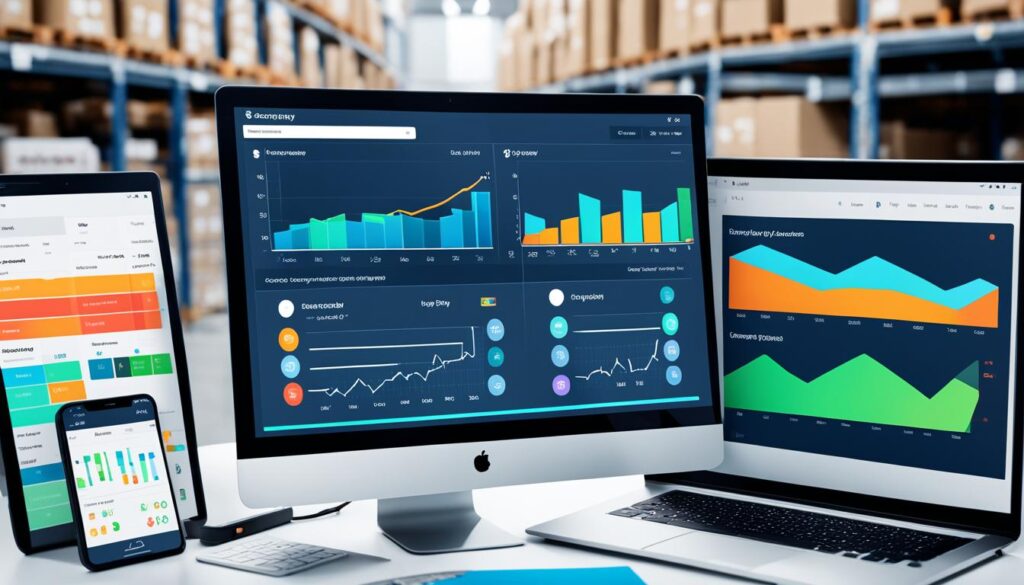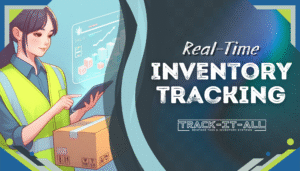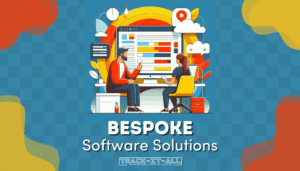We aim to help businesses like Track It All in South Africa manage their stock better and improve their operations. The right inventory management software is key for this. It helps keep track of stock levels and moves goods from suppliers to customers smoothly. When choosing such software, it’s important to think about the business’s needs. This includes the industry, size, budget, and what features are wanted.
Good inventory management stops stock running out, cuts costs, and makes customers happier. Looking ahead to 2024, we see top solutions like Brightpearl and Cin7 for various industries. For smaller businesses, Ordoro and inFlow are great options. Katana is ideal for manufacturing needs, and Zoho Inventory is known for its ability to work with other systems.
Choosing the right system can help businesses meet their goals by making them more efficient and profitable. It’s important to make sure the software works with what you already use and can grow with your business.
Key Takeaways
- Inventory management software can help increase ROI and prevent product overstock or stockouts.
- Some providers offer inventory management software on a free trial basis, allowing users to assess its suitability.
- Small to medium-scale manufacturing businesses require easily customisable inventory management software to match their specific needs.
- User-friendly inventory management software helps to streamline operations and increase efficiency.
- Benefits of using inventory management software include time-saving, improved planning, preventing stockouts, vendor satisfaction, accurate reporting, better warehouse management, and enhanced supply chain performance.
Understanding Inventory Management Software
Inventory management software is changing how businesses manage their stock. It’s crucial to have strong inventory tracking software and smart inventory optimisation solutions. These tools help keep the right amount of stock and meet customer needs, making businesses run better.
What is Inventory Management Software?
This software has tools to track inventory, orders, sales, and deliveries automatically. It’s key for smooth supply chain management. It helps avoid stockouts and overstocking by tracking inventory in real-time. Businesses can pick from cloud-based or on-premises options that suit their needs.
Benefits of Using Inventory Management Software
Using software like Track It All brings big benefits:
- Automation cuts down on manual work and lowers costs.
- It gives real-time data for better decisions and quick action.
- Customers get consistent orders and fewer stock issues.
- It helps predict demand and order stock on time.
- It works well with other tools, making everything run smoother.
Key Features to Look for
When choosing an inventory system, look for features that boost efficiency:
- Live updates keep inventory levels correct across all platforms.
- Forecasting tools predict what stock you’ll need next.
- Auto-reordering systems manage stock replenishment.
- Barcode scanning makes entering data fast and accurate.
- It should work well with your current supply chain tools.
These features cut down on manual work and speed up order fulfillment. This leads to better inventory management and higher profits.

Using top inventory management systems like Veeqo, Brightpearl, or Tradegecko gives a competitive edge. They offer detailed reports, align with sales across channels, and help manage customer relationships well. For more on how to improve your inventory management, check out this guide on strategic inventory management.
Choosing the Right Inventory Management Software
Choosing the best inventory management software is crucial for businesses looking to improve their stock handling. It’s important to know what you need, especially about your industry, business size, budget, and key features. Let’s look at these factors closely.
Your Industry Needs
The software you pick must meet your industry’s specific needs. For example, Track It All shows how important it is to have solutions made for your industry. They help manage stock well, cut costs, and make customers happier.
Size and Scale of Your Business
It’s key that the system fits your business size and can grow with you. Small businesses need software that’s right for now but can expand as they do. This means the software should grow with your business.
Budget Considerations
Prices for top inventory management systems vary, so setting a budget is crucial. You want software that’s affordable but still has all the important features. These include tracking stock in real time, managing orders, suppliers, and working well with other systems.
Desired Features
Look for software with automation, barcoding, tracking stock always, reports, and analytics, and mobile access. For businesses selling to both consumers and other companies, managing sales across different channels and linking with POS systems is essential.

As Brightpearl points out, the right software helps with forecasting, makes operations smoother, and ensures you have the right stock levels. This leads to saving money and making customers happier.
In short, picking the best inventory management software means looking at your industry, business size, budget, and what features you need. This helps you make a choice that fits your business’s needs and helps it grow.
Top Inventory Management Solutions in 2024
As we move into 2024, the world of inventory software is changing. It now offers powerful inventory management tools for different business needs. Veeqo, Brightpearl, and Tradegecko are leading the way with their advanced solutions.
- Veeqo: Veeqo stands out by linking orders, inventory, and shipments across multiple channels. This makes it a top choice for managing inventory smoothly.
- Brightpearl: Brightpearl is perfect for retailers who sell wholesale and across many channels. It combines order and inventory management with accounting, making complex tasks simpler.
- Tradegecko: Tradegecko is great for businesses that make and sell products. It handles standard inventory needs and the complex tasks of production, making it a standout option.
- Cin7: Cin7 offers two top software options, Core and Omni. It works well with platforms like Shopify and Amazon. This means businesses can track inventory in real-time and keep it in sync across all sales channels.
- NetSuite: NetSuite is ideal for larger companies. It offers detailed automation to make managing inventory easier and is priced upon request.
Each inventory management tool has different prices and features to suit various needs:
| Software | Starting Price (per month) | Key Features |
|---|---|---|
| inFlow | $110 | Works with major platforms, includes barcode scanning |
| Katana | $99 | Great for small to medium businesses |
| Sortly | Free | Designed for small businesses |
| Zoho | $29 | Integrates with Zoho CRM |
| Ordoro | $59 | Offers 30-day free onboarding, connects with sales channels |
As noted on Track It All, picking an inventory system that keeps improving and offers support is key. Features like automation help save time and reduce mistakes, which are common causes of inventory issues.
Today’s top inventory software uses tech like RFID and barcode scanning for tracking in real-time. It also connects with accounting, CRM, and ERP systems. This helps businesses manage inventory better and avoid financial losses from overstock or shortages.
In conclusion, choosing the right inventory management software is crucial. It not only improves warehouse operations but also helps businesses grow and stay strong in South Africa’s fast-changing market.
Conclusion
Businesses have many factors to consider when managing their inventory. They must think about their industry, size, and financial plans. Choosing the right inventory management software is crucial. Solutions like Brightpearl, Cin7, and Veeqo show how technology can improve operations.
Companies like Track It All can greatly benefit from these advances. They ensure operations run smoothly and profitably.
When looking at software, it’s important to consider scalability and how well it works with other systems. Good support services are also key. These programs adapt to future needs and give real-time stock updates.
About 90% of users see big benefits in better warehouse management and accurate reports. This shows how these apps help businesses improve. They also help with inventory control and make vendors happy with timely deliveries.
Using inventory optimisation solutions helps predict sales and increase revenue. These tools offer long-term growth benefits. They reduce manual tasks by up to 40% and save time, boosting productivity.
Using warehouse management systems turns inventory management into a strategic asset. It helps businesses become more efficient and successful.







